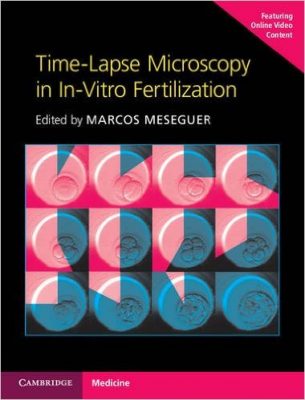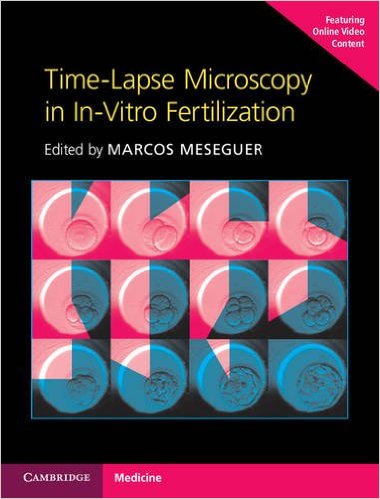 Editor: Marcos Meseguer
Editor: Marcos Meseguer
Publisher: Cambridge University Press – 176 pages
Book Review by: Sonu Chandiram
In-vitro fertilization is a fascinating field. You can view time-lapse photos in this unique book and see for yourself how the male and female gametes work to create a new human being in a petri dish. This happens through a pre-defined plan in nature. Understanding the process of how an embryo is created is what this book is about. But setting the stage to eyewitness this miracle to happen took many years of study, research and implementation.
Twenty-three scientists from Europe and the United States show you in-vitro fertilization in this not-too-long book of less than 180 pages, and much of the material is visual in form: charts, micrographs, photos, tables, and other types of images. The writers of the chapters (titles shown below to give you an overview of the contents of this book) are from Austria, Denmark, France, Germany, Hungary, Italy, Spain, and the United States.
- Introduction: IVF concepts, embryo development, and embryo selection
- Description of time-lapse systems: EmbryoScope
- Description of time-lapse systems: Primo Vision
- Description of time-lapse systems: the Eeva Test
- Morphological cytoplasmic oocyte alterations: embryo kinetics of dysmorphic oocytes
- Evaluating embryo development stages using time-lapse microscopy (TLM)
- Embryo quality (classification and selection)
- Time-lapse implementation in a clinical setting: management of laboratory quality
- Time-lapse implementation in a clinical setting: outcome results
- Unusual phenomena in embryonic development
Besides this print book, you can also see its online version.
You as purchaser of this book can access online the contents of this book: text and images, which are fully searchable.
Here’s how you set up your Cambridge Books Online account:
- Go to http://ebooks.Cambridge.org/register and Click Register
- Enter your details and click Submit
- You’ll receive a confirmation email
- Follow instructions in that email to activate your registration
To activate your access code using your Cambridge Books Online account:
- Scratch off the Activation Code found on the inside from cover of your book
- Go to http://ebooks.Cambridge.org and click Login, followed by User Login
- Log in using your Cambridge Books Online account
- Click on My Bookshelf
- Enter your Activation Code and click on Activate Now
- Click on the book’s title to view the book’s content
Please note that this book cannot be returned once the access code has been revealed. For technical assistance, please see http://ebooks.Cambridge.org/contact.jsf Further information about using and navigating your online access may be found on the online User Guide once you have activated your code.
The field of ‘assisted reproduction’ as Natalia Basile terms it in the Preface, is constantly seeking improvement.
She recounts: “The study of the embryo’s metabolism was crucial for the formulation of suitable culture media. In the 1990s a groundbreaking technique, ICSI (intracytoplasmic sperm injection) revolutionized the treatment of male infertility. Later on as we entered the field of genomics, we began to understand the extraordinarily detailed genetic assemblage that determines the fate of an embryo, a process governed by molecular mechanisms and signaling pathways.”
This book has much new to offer, especially in the three chapters on the time-lapse devices in understanding fertilization. Chapter 2 on the EmbryoScope system for example, informs us that this device provides “a stable incubation environment and automated high-quality imahge acquisition. Images are continuously collected and stored in a database for constant access and analysis through the EmbryoViewer software and the ES server.”
Images are acquired by this device in intervals as short as 10 minutes. It has custom-defined numbers of focal planes, and exposure to light is is than in standard observation conditions. It has a highly flexible capability of culturing and logging of embryos during development. The other two chapters on time-lapse systems, and all other chapters are also very informative.
This book is uniquely valuable to medical students, residents and fellows in obstetrics and gynecology, and reproductive medicine research scientists working in the field of assisted reproductive technologies. It provides you a visual atlas of human embryo development using several devices as mentioned above in the list of chapters. This book could also be of interest to childless infertile couples.
Editor:
Marcos Meseguer is Scientific Supervisor and Senior Embryologist at IVI Valencia, and Assistant Professor in Biotechnology at Valencia University in Valencia, Spain.
Contributors:
Inge E. Agerholm, Belen Aparicio-Ruiz, Natalia Basile, Maura Caiazzo, Mariabeatrice Del Canto, Alice A, Chen, Giovanni Coticchio, Thomas Ebner, Rubens Fadini, Thomas Freour, Tine Q. Kajhoj, Marcos Meseguer, Markus Montag, Dean E. Morbeck, Csaba Pribenszky, Mario Mignini Renzini, Zev Rosenwaks, Maria Jose de los Santos, Shehua Shen, Lei Tan, Alberto Tejera, Nikica Zaninovic, and Qiansheng Zhan.







